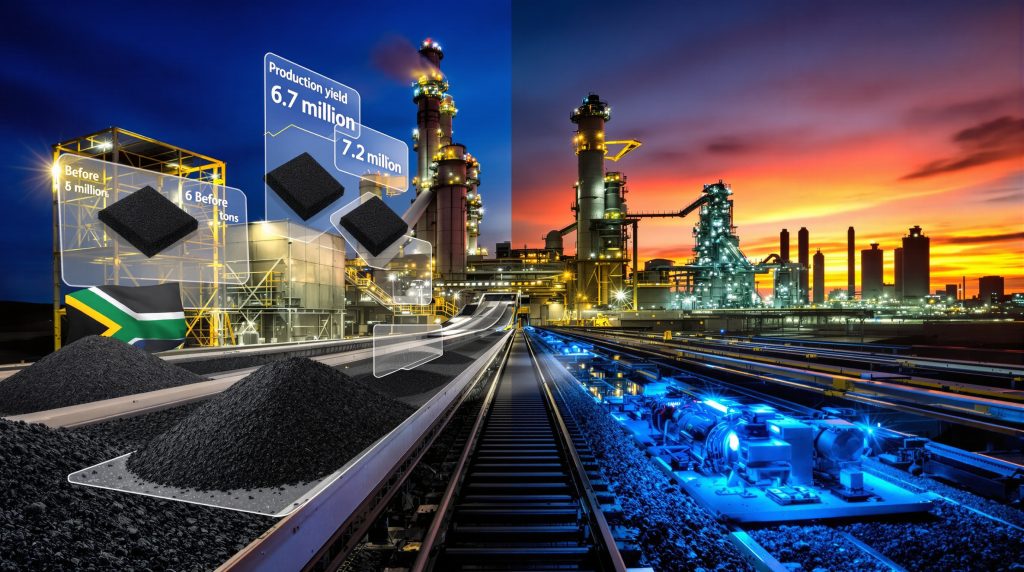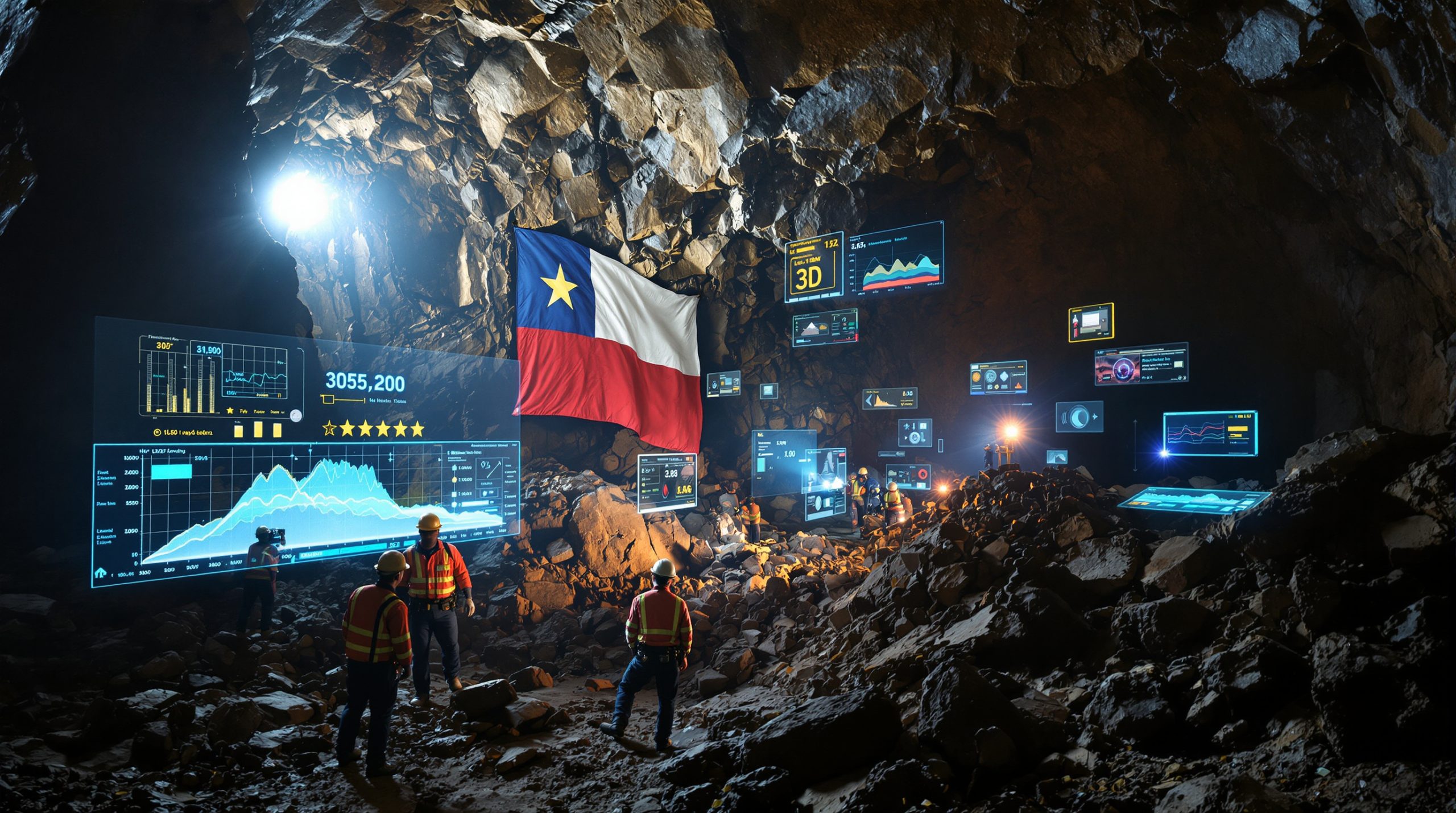Sasol's Coal Destoning Investment: Boosting Secunda Production Volumes
Sasol's recently completed coal destoning plant represents a strategic investment aimed at addressing persistent coal quality issues that have hampered production at its Secunda Operations. The facility, which involved repurposing the Twistdraai export coal plant at an investment of less than R1-billion, is already producing coal with significantly reduced impurities—achieving a 'sinks' content (rock fragments and other impurities) of between 0% and 1.5%.
This brownfield project addresses a critical operational challenge that has negatively affected gasifier yields and caused mechanical damage throughout Sasol's production chain. By improving coal quality, the company aims to enhance both production volumes and operational reliability at its Secunda facility.
How Does Coal Destoning Technology Improve Sasol's Production Efficiency?
Coal destoning technology represents a significant advancement in Sasol's operational capabilities. The newly completed facility directly tackles the persistent issue of high impurity levels in coal feed, which has been a longstanding challenge for the company's gasification process.
The 10-million-ton-a-year capacity plant processes coal with high levels of impurities, removing rock fragments and other non-combustible materials before the coal enters the gasification process. This preprocessing significantly improves the quality of the feedstock, with processed coal achieving remarkably low sinks content of between 0% and 1.5%.
When blended with coal from Sasol's mines and external sources, the processed material achieves an average sinks content of 12-14%, which represents the optimal quality level for Sasol's gasification process.
Technical Process and Implementation
The destoning process employs density separation techniques that effectively remove higher-density rock materials from the coal. This represents a substantial upgrade from previous processing methods that couldn't adequately address the high impurity levels from certain mining areas.
Some key technical aspects of the destoning facility include:
- Advanced density separation systems that can process 10 million tons annually
- Repurposed infrastructure from the Twistdraai export coal plant, minimizing capital expenditure
- Integration with existing coal supply logistics to maintain operational flow
- Real-time quality monitoring systems to ensure consistent output quality
Economic Benefits of Improved Coal Quality
The economic case for coal destoning is compelling. Poor quality coal with high sinks content causes significant downstream issues:
- Reduced gasifier efficiency – High impurity levels decrease the amount of gas produced per ton of coal
- Increased maintenance costs – Rock fragments cause mechanical damage to gasifiers and downstream equipment
- Production downtime – Equipment failures from poor coal quality lead to unplanned shutdowns
- Underutilization of coal resources – Previously, high-impurity coal areas had to be abandoned or avoided
By addressing these issues at the source through destoning, Sasol creates value across the entire production chain. Furthermore, this approach aligns with broader mineral beneficiation opportunities that can enhance resource value.
What Production Improvements Can Sasol Expect From Coal Destoning?
The implementation of coal destoning technology is expected to deliver multiple significant production improvements at Sasol's Secunda Operations. These benefits extend beyond simple volume increases to encompass operational reliability, equipment longevity, and resource utilization.
Increased Gas Yield
One of the most immediate and measurable benefits will be increased gas yield from Sasol's gasifiers. By reducing the non-combustible content in the coal feed, more of the material entering the gasifiers can actually be converted to synthesis gas.
Industry analysts estimate that for every percentage point reduction in sinks content, gasification efficiency can improve by approximately 0.8-1.2%. With the destoning plant reducing average sinks content by several percentage points, the cumulative effect on gas production will be substantial.
Enhanced Mechanical Integrity
The presence of rock fragments in coal feed causes significant mechanical wear throughout the gasification system. These abrasive materials damage:
- Feed handling equipment
- Gasifier internals
- Downstream processing units
- Ash handling systems
With cleaner coal feed, Sasol can expect reduced maintenance requirements, fewer unplanned shutdowns, and longer equipment lifespans. This translates directly to improved plant availability and reduced maintenance costs.
Improved Operational Stability
Consistent coal quality leads to more stable gasifier operation. With the destoning plant delivering coal with predictable sinks content, operators can optimize gasifier parameters more effectively, leading to:
- More consistent synthesis gas composition
- Improved downstream process efficiency
- Reduced process upsets and production interruptions
- Better energy efficiency across the facility
Resource Utilization Benefits
The destoning plant enables Sasol to extract value from previously unusable coal reserves. Mining sections that were closed due to poor coal quality can now be reopened, as the destoning plant can process this material to acceptable quality levels.
This improved resource utilization extends the productive life of Sasol's coal mines and reduces the company's reliance on external coal purchases, creating both operational and financial benefits. The approach represents a significant advancement in modern mine planning techniques that maximize resource value.
What Are Sasol's Production Targets Following the Destoning Investment?
With the destoning plant expected to reach full production capacity by December 2025, Sasol has established a clear production trajectory for its Secunda Operations. These targets reflect the company's confidence in the destoning technology's ability to enhance operational performance.
Short to Medium-Term Production Goals
Sasol's production targets for the coming years demonstrate a progressive improvement pathway:
| Financial Year | Production Target (million tons) |
|---|---|
| 2026 | 7.0 – 7.2 |
| 2027-2030 | ~7.0 (sustained) |
| 2034 onwards | 6.4 (planned reduction) |
The 2026 target represents a significant improvement over the 2025 actual production of 6.7 million tons, which fell short of that year's target range of 6.8-7.0 million tons. This projected increase directly reflects the anticipated benefits of the destoning plant reaching full operational capacity.
Sustaining Production Through 2030
The company's ability to sustain production at approximately 7 million tons annually through 2030 depends on multiple factors:
- Continued effectiveness of the destoning plant
- Successful management of coal quality from Sasol's mines
- Optimization of coal blending strategies
- Strategic external coal procurement
- Maintaining gasifier mechanical integrity
This sustained production level represents optimal utilization of Sasol's Secunda facility, balancing maximum output with sustainable operations.
Planned Production Reduction from 2034
The planned reduction to 6.4 million tons from 2034 reflects Sasol's strategic adaptation to changing resource availability. This reduction coincides with the anticipated depletion of natural gas supplies from Mozambique, which currently supplement Sasol's coal-based operations.
This forward-looking production plan demonstrates Sasol's pragmatic approach to resource constraints and highlights the company's commitment to transparent communication about long-term operational expectations. The strategy aligns with evolving mining industry evolution trends focused on sustainability and resource optimization.
How Will the Destoning Plant Affect Sasol's Coal Sourcing Strategy?
The implementation of coal destoning technology creates new opportunities and flexibility in Sasol's coal sourcing strategy. By enabling the use of previously unsuitable coal, the company can optimize its mix of internal production and external purchases to achieve cost and quality objectives.
Reopening Closed Mine Sections
One of the most significant impacts of the destoning plant is the ability to reopen previously closed mining sections. Areas within Sasol's Bosjesspruit and Thubelisha mines that contain coal with high impurity levels (up to 20% sinks content) can now be economically exploited.
This reopening delivers multiple benefits:
- Extends the productive life of existing mine infrastructure
- Increases the total recoverable coal reserves
- Improves the overall economics of Sasol's mining operations
- Reduces the need for new mine development
Optimizing External Coal Purchases
While the destoning plant will enable Sasol to reduce its reliance on external coal purchases, the company will continue to strategically source coal from third parties. In the 2025 financial year, Sasol produced 28.2 million tons internally (down from 30.2 million in the prior year) while purchasing 10 million tons externally, according to Sasol's capital markets presentation.
The company's external purchasing strategy considers several factors:
- Quality blending requirements – External coal with specific properties can be blended with Sasol's own production to achieve optimal overall quality
- Cost optimization – In some cases, purchasing coal may be more economical than producing it from certain mine sections
- Production flexibility – External purchases provide a buffer against production disruptions at Sasol's own mines
- Long-term contract management – Replacing the current Thungela Resources' Isibonelo colliery contract with a similar long-term arrangement
Balancing Quality, Quantity, and Cost
The destoning plant gives Sasol greater flexibility in balancing these three critical factors in its coal sourcing strategy. By processing lower-quality coal to acceptable standards, the company can make coal sourcing decisions based more on cost and availability, rather than being constrained by rigid quality requirements.
This flexibility will allow Sasol to:
- Prioritize cost-effective internal production where possible
- Supplement with strategic external purchases as needed
- Maintain consistent overall coal quality through effective blending
- Reduce reliance on premium-quality coal sources that command higher prices
The strategy demonstrates the practical application of cut-off grade significance in resource management, allowing previously uneconomic material to be profitably utilized.
What Challenges Does Sasol Face Beyond Coal Quality?
While the Sasol coal destoning investment addresses immediate production challenges, Sasol faces significant medium-term strategic challenges that will require comprehensive planning and adaptation. These challenges extend beyond coal quality to encompass broader energy transition and resource availability issues.
The "Gas Cliff" Challenge
One of the most pressing challenges is what has become known as the "gas cliff" – the impending cessation of natural gas imports from Mozambique for domestic customers in 2028. This represents approximately 60 PJ of gas that is currently consumed domestically, equivalent to 10-15% of yearly output from Sasol's gasifiers.
To address this challenge, Sasol has developed a transition strategy:
- Commitment to supply domestic customers until 2030
- Replacement of imported natural gas with methane-rich gas (MRG) produced by Secunda gasifiers
- Regulatory engagement with the National Energy Regulator of South Africa (Nersa) on pricing determinations
- Positioning MRG as a bridging solution ahead of LNG imports
This transition comes with significant pricing implications, as MRG is expected to be more expensive than the current natural gas supply. The pricing structure will require regulatory approval, creating both market and regulatory uncertainties.
Long-Term Energy Transition Strategy
Beyond the immediate gas cliff challenge, Sasol must navigate a complex energy transition landscape. The company has determined that using imported liquefied natural gas (LNG) in its own production processes would be uneconomical, creating a strategic dilemma as gas imports from Mozambique end completely in 2034.
Sasol's emerging strategy includes:
- Advocating for gas-to-power applications to anchor LNG imports into South Africa
- Potentially purchasing LNG selectively for high-value products like wax production at Sasolburg
- Sourcing feedstock for other Sasolburg production facilities from Secunda gasifiers
- Potentially replacing some production with imports where economically necessary
This strategy reflects the complex balance between maintaining production, adapting to changing resource availability, and managing economic realities. Additionally, the company must navigate significant energy transition challenges common across the industrial sector.
Industry-Wide Transition Challenges
Sasol's challenges mirror broader transition issues facing South Africa's energy and chemicals sectors:
- Infrastructure limitations – The lack of LNG import facilities constrains transition options
- Regulatory uncertainty – Evolving energy regulations create planning challenges
- Market dynamics – International competition and pricing pressures affect product viability
- Carbon transition pressures – Increasing focus on carbon emissions creates additional constraints
These industry-wide challenges require collaborative solutions between industry, government, and regulators to navigate effectively.
What Does This Investment Tell Us About Sasol's Future Direction?
Sasol's significant investment in coal destoning technology provides valuable insights into the company's strategic priorities and future direction. This investment reveals a multi-faceted approach that balances short-term operational optimization with longer-term strategic positioning.
Short-Term Operational Optimization
The immediate focus on improving coal quality demonstrates Sasol's commitment to maximizing the efficiency and reliability of its existing assets. This pragmatic approach recognizes the substantial value that can be unlocked through operational improvements:
- Enhanced gasifier yields from better quality coal
- Improved mechanical reliability reducing maintenance costs
- Increased production volumes meeting or exceeding targets
- Extended life of existing mine assets through quality enhancement
These short-term benefits deliver immediate value to shareholders while creating a more stable operational foundation for future initiatives.
Medium-Term Production Sustainability
The destoning investment supports Sasol's medium-term goal of maintaining production levels around 7 million tons annually until 2030. This represents a commitment to maximizing returns from established infrastructure during this critical transition period.
Key elements of this medium-term strategy include:
- Optimizing coal sourcing through a blend of internal production and external purchases
- Implementing the methane-rich gas (MRG) solution for domestic customers
- Managing the regulatory process for MRG pricing determinations
- Positioning for the eventual transition beyond Mozambique gas
This approach provides operational stability during a period of significant energy market transformation.
Long-Term Energy Transition Planning
The acknowledgment of reduced production from 2034 signals Sasol's recognition of the need to adapt to changing energy landscapes and resource availability. Rather than maintaining unrealistic production expectations, the company has established a clear trajectory that reflects resource constraints.
This forward-looking perspective includes:
- Selective integration of LNG for high-value products where economically viable
- Strategic sourcing of feedstocks between different production facilities
- Potential product portfolio adjustments based on feedstock availability and economics
- Balanced approach to imports versus local production based on evolving market conditions
Balancing Shareholder Value and Strategic Adaptation
The destoning investment demonstrates Sasol's ability to balance immediate shareholder value creation with longer-term strategic positioning. By investing in technology that improves current operations while creating flexibility for future transitions, Sasol demonstrates a nuanced approach to navigating a complex energy landscape.
This balanced strategy enables the company to:
- Deliver near-term operational improvements that enhance financial performance
- Create transition pathways that manage resource constraints
- Develop adaptable approaches to changing energy markets
- Position for long-term competitiveness in an evolving industry landscape
Conclusion: Balancing Immediate Needs with Future Transitions
Sasol's coal destoning investment exemplifies a strategic approach that addresses immediate operational challenges while positioning for future industry transitions. This R1-billion investment in repurposing the Twistdraai export coal plant demonstrates the company's commitment to extracting maximum value from existing assets while preparing for changing resource landscapes.
The destoning technology delivers multiple immediate benefits—improved coal quality, increased gas yield, enhanced mechanical reliability, and access to previously unusable coal reserves. These operational improvements support Sasol's goal of increasing production to 7.0-7.2 million tons in 2026 and sustaining approximately 7 million tons through 2030.
However, the investment also acknowledges the longer-term challenges facing Sasol and South Africa's energy sector. The "gas cliff" in 2028 and the complete cessation of Mozambique gas imports by 2034 require strategic adaptations, including the transition to methane-rich gas for domestic customers and selective consideration of LNG for high-value products.
This balanced approach—optimizing current operations while planning for future transitions—reflects the complex reality facing industrial companies in today's energy landscape. The success of Sasol's strategy will ultimately depend on its ability to:
- Execute the destoning operation effectively to achieve targeted coal quality improvements
- Successfully manage the transition to MRG for domestic gas customers
- Navigate the regulatory process for MRG pricing determinations
- Develop viable solutions for the post-2034 operational environment
For industry observers, Sasol's approach provides valuable insights into how established industrial companies can navigate the dual imperatives of operational excellence and strategic adaptation in a rapidly evolving energy landscape.
Want to Identify the Next Major Mineral Discovery Before the Market?
Gain real-time alerts on significant ASX mineral discoveries with Discovery Alert's proprietary Discovery IQ model, translating complex mineral data into actionable investment opportunities before the broader market. Visit Discovery Alert's discoveries page to understand why historic discoveries can generate substantial returns and start your 30-day free trial today.




